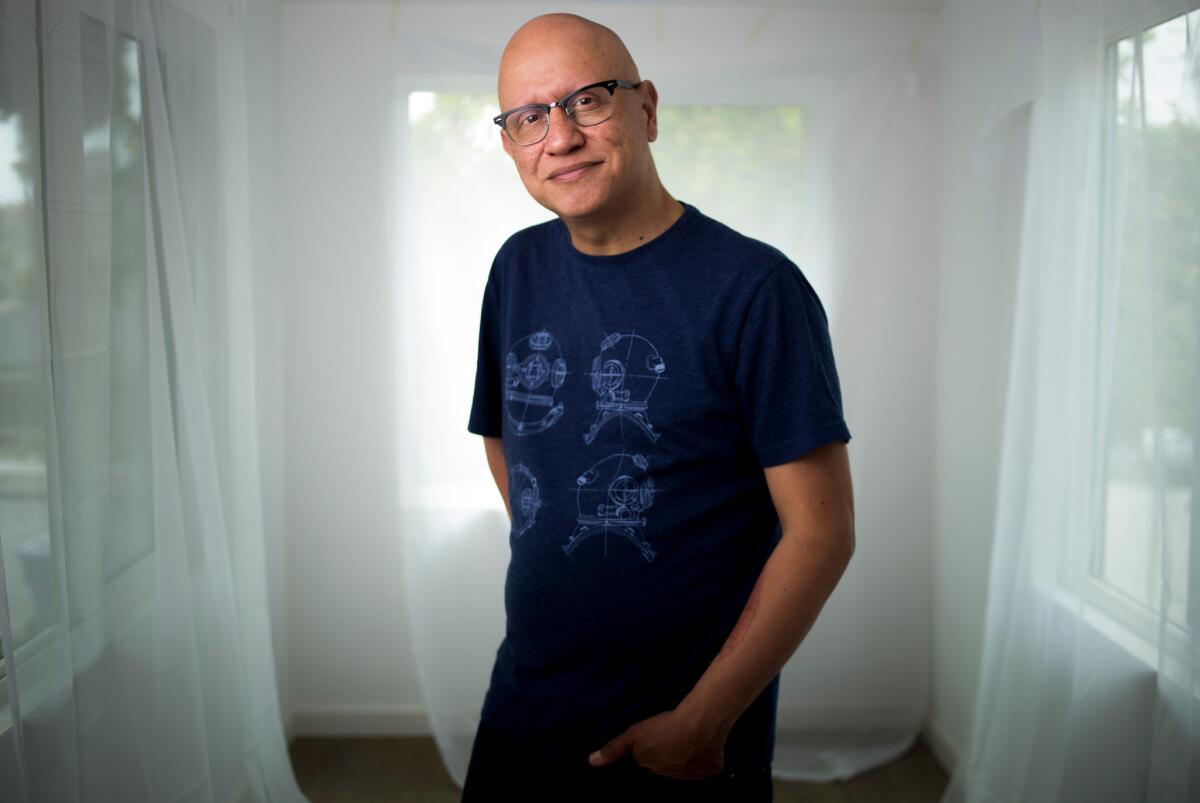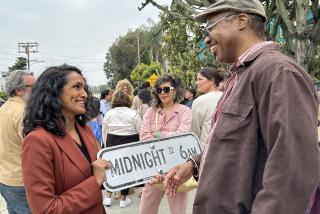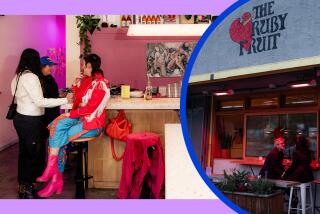Review: ‘Cruising’ maps the cultural history of L.A.’s hookup spots
I had a favorite study carrel at UC Berkeley: third-floor Moffitt Library, northeast corner. The bathroom — folded within an interior wall, set off, secluded — was weird, though. Someone had taken the time to punch a raw opening through the metal partition separating two stalls. It was as big in diameter as a Coke can, sometimes lined with wadded toilet paper, and framed with scrawled hieroglyphics (arrows, initials). I dismissed it as crazy, an elaborate work of vandalism, but it nagged at me. While I studied James Joyce and Virginia Woolf and stressed about my senior thesis, the men’s room was undergoing a silent and illogical transformation.
I probably don’t need to explain how my awareness of sex was evolving, how I was still managing my lust for men in secret while declaring outwardly that I liked women. I was still a virgin with men, still figuring it out. I’d never heard of glory holes or hookups in bathrooms, or of a queer culture of desire that ripples inaudibly through public spaces like an ultrasonic whistle only some of us were born to hear. I was just trying to work out the puzzle of that brazen hole on third-floor Moffitt.
In “Cruising,” L.A. author Alex Espinoza offers a cultural history of gay hookup sex in public spaces. The book’s subtitle, “An Intimate History of a Radical Pastime,” roots the author’s argument in terms of power. Cruising, Espinoza argues, is the signal act of resistance at the heart of queerness (male queerness, anyway). The book’s epigraph is from John Rechy’s “The Sexual Outlaw”: “The promiscuous homosexual is a sexual revolutionary. Each moment of his outlaw existence he confronts repressive laws, repressive ‘morality.’ Parks, alleys, subway tunnels, garages, streets — these are the battlefields.”
So necessary is our desire to connect, to engage in this act of intimacy that we would do almost anything for it, even risk ... our very lives.
— Alex Expinoza
In Espinoza’s argument, oral sex in some public bathroom isn’t just an expression of physical need or a personal act of horniness. It’s an act of insurrection against straightness, a transgressive remaking of the dominant hetero commons. Espinoza suggests that, as an act of nonconformity, of perseverance across generations, and an almost spiritual need for connection, glory-hole sex might be the iconic expression of gay culture.
Espinoza also highlights moments of gay history, like Bob Damron’s “The Address Book” (the first one appeared in 1965), which was a kind of “The Negro Motorist Green Book” for men seeking queer space: gay or gay-friendly bars, motels and restaurants where something like community reigned, or at least there was less risk of getting beaten up or arrested. Mostly, the Levi’s-pocket-sized annual guides told men where to cruise, how to find the toilets, parks, rest stops and back rooms where gay identity was really forged — out of need — in even the smallest country town or loneliest stretch of highway. The Damron guides had intricate codes for how to feed desire: where to find motorcycle dudes, drag queens, posh gays, guys of color; where to dance, or the places your best girlfriend might be welcome to join you. Espinoza traces the rise of the 1970s queer urban language of the hankie code, the colored bandannas gay men flashed in back pockets (right for active, left for passive) to communicate specific appetites: dark blue if you wanted (or sought to give) oral sex; gray if you were into being a master (or acting the slave). Espinoza understands these codes as a vocabulary of need, of the radical expression of identity in a society that pathologized queer desire.

At gay bars and clubs in West Hollywood, he felt shunned and alone. With cruising, though, imbalances of race and class, age and body type, were drowned out.
The author roots his universal understanding of cruising in personal episodes, mostly his. Espinoza was born in Tijuana, to parents from Michoacan, and he was brought to the U.S. at the age of 2. He grew up in the San Gabriel Valley, a Mexican American kid questioning his sexuality, suffocating in his family’s working-class Catholicism and a sense of his own physical inadequacy — “a birth defect,” he writes, “that had stunted the development of my right arm,” plus patchy bald spots, the result of an autoimmune skin disease. But one brutally hot day in 1986 when Espinoza was a teenager waiting at a bus stop, blasting the Smiths through his Walkman, he was cruised by a guy trolling slowly past in his car. The driver wore teal shorts and a muscle shirt. He offered Espinoza a ride.
“I had my first sexual encounter,” Espinoza writes, “and was introduced to a secret world.” It made him aware of the free-flowing, never-ending possibility of sex with men. Suddenly, Espinoza caught cruising looks from guys everywhere: on the street, in movie theaters and mall food courts, in parks. “It was all so random,” he writes.
Cruising had the power to erase most of the inequities Espinoza struggled with. He was a poor Latino kid with a non-standard body and the wrong clothes. At gay bars and clubs in West Hollywood, he felt shunned and alone. With cruising, though, imbalances of race and class, of age and body type, were drowned out, mostly, by the rustle of clicking belt buckles and opened zippers, of jeans dropping around ankles to land on the floor.
“This ‘deviant’ act strengthened my awareness of myself in relation to my body,” Espinoza writes. “That culture of secret exchanges, of brief intimacy and lust, allowed for confidence to take root inside of me, supplanting any feelings of insecurity I had developed and had too easily learned to live with.”
The promiscuous homosexual is a sexual revolutionary. Parks, alleys, subway tunnels, garages, streets — these are the battlefields.
— John Rechy
Memoir is the powerful heart of Espinoza’s book, the places where he makes us feel the power of cruising as what he calls a “cultural identifier” of gay experience, the act that marks us as constitutionally different from straight people. Other places in “Cruising,” Espinoza seems less engaged. He runs up against historical erasure when he tries to catch a whiff of cruising in ancient Greek and Roman societies. His quick swings through Renaissance Florence, 18th-century Paris and Mother Clap’s London molly house, to show how the rise of the modern city of crowds and anonymity made cruising possible, feel random and cursory. But when he takes us to the L.A. he knew, to the gayopolis of WeHo he experienced at 19, where bookstore owners thought nothing of displaying Inches magazine, Espinoza makes us feel the power of carving out queer spaces in the wider city.
Espinoza also struggles with modern gay hookup apps (Grindr, Scruff, Growlr, BRO, Hornet, DaddyHunt) and how to place them in the history of cruising. Are they even cruising or, since they change the physical dynamics of seeking sex, are apps the death of cruising? This is an urgent question Espinoza fails to explore, even by quoting other works, for instance Jaime Woo’s 2013 book “Meet Grindr,” in which he argues that the app continues “the queer historical tradition of subverting normative uses of space,” providing “a potential sexual subtext to any location.”
“Cruising” does better at capturing a moment fixed in analog time, when guys circled the blocks in Valley suburbs, stopping to ask if you needed a ride. “It happens,” Espinoza writes, “it continues to happen, because it simply cannot not happen. So urgent, so necessary is our desire to connect, to engage in this act of intimacy that we would do almost anything for it, even risk exposure, arrest, our very lives in some parts of the world.”
As for me, fixed in analog time in the third-floor bathroom at Moffitt Library, I found out later, long after it had been closed up with a metal plate, the graffiti scrubbed off, what that opening was for. Though I was clueless then, still it was part of a legacy of queerness that belonged to me, a way of understanding myself as a gay man, of being honest in a world that tried to keep me from being who I was. “A way we push past the darkness,” Espinoza writes, “and into something resembling light.”
::
“Cruising: An Intimate History of a Radical Pastime”
Alex Espinoza
Unnamed Press: 238 pp., $21.99
Birdsall is a James Beard Award-honored writer working on a forthcoming biography of James Beard.
More to Read
Sign up for our Book Club newsletter
Get the latest news, events and more from the Los Angeles Times Book Club, and help us get L.A. reading and talking.
You may occasionally receive promotional content from the Los Angeles Times.








